Directions (1-5): Study the following information carefully to answer the given questions:
There are six employees of a company and all of them are working on six different designation of a company viz. CMD, MD, CEO, COO, SE, JE. All the designations given are to be considered in a given order (as CMD is considered as Senior-most and JE is considered as the Junior-most). No one is older than 55years.
R is junior than U, who is not MD. The one who is MD is 4years younger than CEO. More than two persons are junior than P. Age of the one who is JE is a perfect square of an odd number. Q is Junior than S but senior than R. Age of the one who is CEO is just double the age of the one who is JE. U is senior to T who is not JE. S is not COO. Age of the one who is COO is a perfect square of number and 10years younger than S. The one who is CMD is 5years older than the one who is CEO. S is junior to P. U’ age is an even number. T is 6years younger than S. Q is 11years older than R. Age of the one who is JE is not less than 20years.
Q1. Who among the following is CEO of the company?
(a) P
(b) T
(c) the one who is 46years old
(d) U
(e) None of these
Q2. Who among the following is 55years old?
(a) U
(b) P
(c) S
(d) Q
(e) None of these
Q3. What is the age difference between U and T?
(a) 15years
(b) 10years
(c) 12years
(d) 8years
(e) None of these
Q4. How many persons are junior to R?
(a) Four
(b) One
(c) Three
(d) Two
(e) None
Q5. Who among the following SE of the company?
(a) Q
(b) U
(c) T
(d) R
(e) None of these
Solutions (1-5):
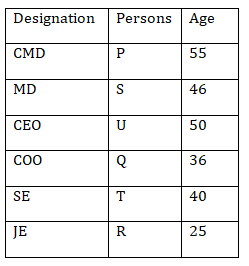
S1. Ans.(d)
S2. Ans.(b)
S3. Ans.(b)
S4. Ans.(e)
S5. Ans.(c)
Directions (6-10): Study the following information carefully and answer the questions given below:
In a certain code language
‘Traffic Safety Failure’ is written as ‘@G #I #R’
‘Status Edge Conflict’ is written as ‘@T @F @X’
‘Oppose Victory Claim’ is written as ‘#I #R #H’
Q6. What is the code for ‘Linkage’?
(a) #T
(b) @U
(c) @T
(d) #V
(e) None of these
Q7. What is the code for ‘Should Clarify’?
(a) #O @U
(b) @O #V
(c) #T @M
(d) @O #U
(e) None of these
Q8. What is the code for ‘Shows’?
(a) @D
(b) #E
(c) #D
(d) @C
(e) None of these
Q9. What is the code for ‘Attractive’?
(a) #R
(b) @E
(c) #G
(d) @T
(e) None of these
Q10. What is the code for ‘Badminton’?
(a) #C
(b) @H
(c) #G
(d) @L
(e) None of these
Solutions (6-10):

S6. Ans.(c)
S7. Ans.(d)
S8. Ans.(a)
S9. Ans.(b)
S10. Ans.(d)
Directions (11-13): Study the following information carefully and answer the questions given below:
A person starts walking from point A in west direction and walks 8m and reach at point B. From point B he takes two constitutive left turn and walks 12m and 4m to reach at point C. From point C he walks in south direction and walks 6m to reach at point D. Then finally takes two constitutive left turn and walks 10m and 18m to reach at point E.
Q11. What is the shortest distance between his initial point and final point?
(a) 12m
(b) 14m
(c) 6m
(d) 10m
(e) None of these
Q12. What is the direction of point B with respect to point D?
(a)North-East
(b) South-West
(c) South-East
(d) North-West
(e) None of these
Q13. What is the shortest distance between Point E to point C?
(a) 3√5m
(b) 28m
(c) 2√61m
(d) 5√41m
(e) None of these
Solutions (11-13):
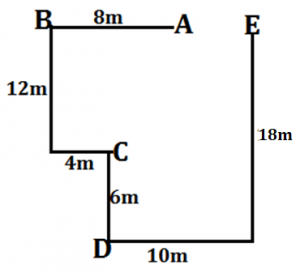
S11. Ans.(c)
S12. Ans.(d)
S13. Ans.(c)
Directions (14-15): In each of the questions given below some statements are followed by some conclusions. You have to take the given statements to be true even if they seem to be at variance from commonly known facts. Read all the conclusions and then decide which of the given conclusions logically follows from the given statements disregarding commonly known facts.
Q14. Statements: Some yellow is golden.
All golden is silver.
Only few White are yellow.
Conclusions:
I. Some yellow is silver.
II. Some silver is white.
III. No white is golden.
(a) Only II is true
(b) Only I is true
(c) Only III is true
(d) Both I and III is true
(e) None of these
S14. Ans.(b)
Sol.
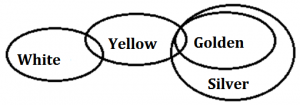
Q15. Statements: All snow are stone.
Only few snow is sand.
No water is snow.
Conclusions:
I. Some water is stone is a possibility.
II. All stone is sand is a possibility.
III. No sand is stone.
(a) Only I is true
(b) Both I and II is true
(c) Only II is true
(d) Both II and III is true
(e) None of these
S15. Ans.(a)
Sol.
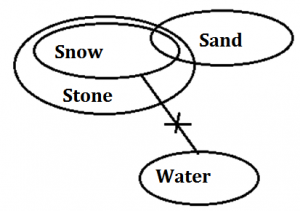
If you are preparing for Bank exams, then you can also check out a video for Reasoning below:


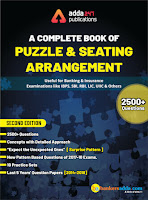


 GA Capsule for SBI Clerk Mains 2025, Dow...
GA Capsule for SBI Clerk Mains 2025, Dow...
 The Hindu Review October 2022: Download ...
The Hindu Review October 2022: Download ...
 ECGC PO Scorecard 2025 Out, Check Marks
ECGC PO Scorecard 2025 Out, Check Marks




